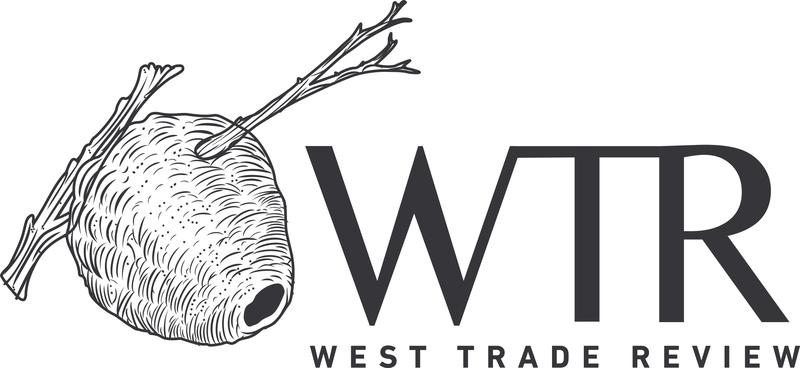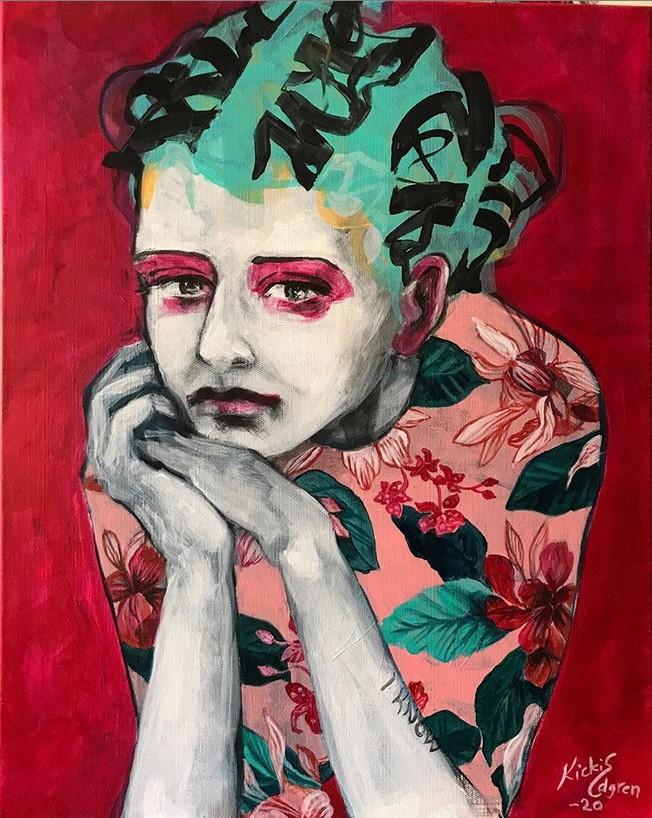Kicki Edgren is a Swedish artist who had her first exibition at 15 and began to paint portraits when she was 16. She is also a writer, illustrator, and designer for whom medium is secondary to expression and creativity.
West Trade Review Online Exclusive: Interview with Kicki Edgren
This interview was completed for West Trade Review by Shannon Barbour in collaboration with other West Trade Review staff. Barbour is a MFA candidate at the Bennington Writing Seminars and writes essays and poems. She lives in Mississippi with her husband and daughter.
WTR: Have you always been interested in art? What were some of your earliest artistic endeavors – did you paint or draw or do something else entirely?
KE: I have created stuff for as long as I can remember. I have always been a “I can do it myself” person. Instead of reading a book, I did my own, instead of putting a poster from a magazine on my wall, I drew my own. If I wanted a special thing or furniture, I built it by myself in my dad´s garage. So yes, I was born to create. To learn, I could, for example, study an object, an image or an ad for hours to understand shapes, lightning, anatomy, composition, colors and expression. When it comes to art, I was mainly drawing as a child. After a while I started painting in colors, using different materials and techniques. But at the age of 15, I started to paint in oil on canvas. I never wanted to be a painter, but I dreamt of being an illustrator. So, as an adult I freelanced mainly as an illustrator. After 18 years, I got bored of making illustrations for magazines, advertising agencies and publishers, so I stopped. Made more room for exploring other areas within design and more time to live. And started to paint again.
WTR: Who were your earliest influences? How did they affect your work? Who continues to influence you; what medium do they work in? Is there any one artist or artwork you think everyone should be familiar with?
KE: My parents were very interested in art and culture, so our family travelled a lot. I almost grew up in museums and old churches all around Europe. But very early on I realized that some art fascinated me more than others. The “old” art (before 1900) I found boring; the modern art, on the other hand, struck me. I found my own favorites. The Surrealists took me by storm during my teenage years, but then I began to appreciate the color and shape and clear surfaces and lines more than the choice of motif itself, as in Matisse, Toulouse-Lautrec, for example. I then began to love expressionism and abstract art, such as Rotkho, Pollock, Kirkegaard and Miro among others. In addition, I’ve always been obsessed by graffiti art. I like the rawness. Nowadays I appreciate all sorts of art, mostly figurative art. I found it hard though, to enjoy paintings of landscapes and flowers. Don’t know why.
The latest art experience was an exhibition with works by Hilma af Klint, a previously unknown abstract artist from the first part of the 1900s. Her works made me travel to another dimension. Totally magical art.
WTR: Your work seems to move across all mediums, is there one you prefer?
Difficult question. Maybe there are favorites. But for me it's about creation, to build something interesting for a particular context: a painting on the wall, a visual concept for a company, or a book cover. I'm restless so I want to try everything. If I had to choose only one medium, I would get bored after a while.
WTR: How did you train as an artist?
KE: I’ve gone through several art educations, among them a Masters in Fine Art at the University of Gothenburg. But really, to be honest, the learning happens in private spaces in spare time, just on your own. For me it’s about life-long interest in looking, analyzing, studying how things look, how the light and shadow fall over a hand, the design of milk packaging, the shapes of the clouds in a summer evening, the rhythm of the pattern in a wallpaper, the character in a type-face, the glitter in one’s eye. When knowing how things look, you can eventually go forward by breaking it down, explore and exaggerate shapes and colors, express it differently, in a crazy or personal way. That’s the real training. Education is only a nice text on a CV.
WTR: On your website, you say that your kitchen can quickly be turned into your studio so you can transition from cooking to painting quickly. Has that always been part of your process, to use one space in a variety of ways?
KE: I live with my two sons in an apartment with only three rooms. And I prefer to paint in my home, that’s why I don’t have a studio. But in small spaces, you have to find solutions. The kitchen became the place where I could be at peace and have my "own" room. And of course, create a space that can be two things is also creation — that gives me an extra kick!
WTR: You also say you work on Tuesdays. Why Tuesday?
KE: I usually wait for inspiration and the desire to paint, which meant that for some long periods, I did not feel like it, so no artwork was made. But then, one year, I tried to take time off from my regular job on Tuesdays. And it actually worked. Every Tuesday I could paint without interruption from morning to night; it became a necessary focus in my life. I forced myself to create, regardless of whether I wanted to or not. Sure, sometimes I struggled for a couple of hours, but then it always turned into a will, flow, and I enjoyed every second. My goal was to make one finished painting every Tuesday, which I did. All of those I then exhibited and sold most of them.
WTR: What is your process like for creating new work? How do you decide on a topic?
KE: It varies. Sometimes I just want to paint, just for the feeling and then it is mainly the composition, the colors and the shapes that I constantly experiment with, and the motif itself comes second. But at the same time, I always want to express a feeling or a mood in my paintings. In cases where I want to tell a story in the motif, I try to do it subtly, open to interpretation, so as not to be overly clear. Since I always paint people, the story can be told through someone's gaze, or posture.
WTR: How would you describe your technique?
KE: I start to cover the canvas with thick paint, preferably different colors with a putty shovel. This first layer of paint contributes to texture and a vibrant look. I then cover it all with the next layer, which is more transparent because the raw base contributes to something exciting in my motif. I paint the motif in many layers until I get what I want. But it is a struggle. Because I’m a perfectionist, if I don’t get it right, I hate it and get angry with myself and the canvas becomes a battlefield. So often I paint over a picture several times until I’m satisfied. In many of my canvases, four or five paintings are hidden under the final version. That’s why I mostly paint in acrylic, because it matches my temperament and my restlessness: it dries quickly!
WTR: I know you work with textiles – let me please interrupt this question to say that Off the Wall was genius! I am a huge fan – and it seems as though textiles appear in many of your paintings, which provides a vibrant and rich texture as well as palette. Can you speak to that at all? Is there a message to these patterns?
KE: I like flat, free surfaces, but I also like patterns and structures. Filling certain areas with patterns adds another dimension to the image, sometimes purely decorative, sometimes with stories. But it is a completely different process to make wallpaper or textile patterns that are to be repeated and experienced harmoniously than to paint certain surfaces on a canvas. The latter is unpretentious and has no rules.
WTR: How does color play into your composition? Does color lead you into a subject or does the subject matter dictate the color? Or do you see the entire piece as working in some unified tandem before you even begin?
KE: Color is always very difficult to compose, but I cannot be without them. My works are mostly colorful, using clear and distinct colors. I devote a large part of my creation to planning, testing, and combining colors to get harmony and to achieve the expression I am looking for. But it's not just color, I also work with the composition of dark and light surfaces for dynamism and balance. Both color and contrast are extremely important to me. In order for the colors to shine (and be bearable to look at), I often create calmer surfaces in neutral colors such as gray, white, black or beige.
WTR: Black and white and vibrant colors are juxtaposed in your work; does this have a significance or symbolism?
KE: No, not really. Or maybe, I feel power in the vibrant colors, and I think art has the role to be powerful, like a blow to the stomach or a loud scream. I could probably not produce a beige/brown painting; that is not me. The black and white highlights the color, but they has also a calming effect, gives you a chance to breathe. But mostly it’s about contrast — the lightest and darkest color in the palette is absolutely necessary for me. I often have black contour lines around figures to dampen three-dimensionality. I really like to mix the flat with the three-dimensional. Combining the cartoonic style with the realistic.
WTR: Your Falling pieces are quite striking: even on the flat surface of a computer screen, the texture of the works is evident. What does the falling represent in these pieces? On the website, you mention that they can hang any direction: would the direction alter the meaning?
KE: In those falling pieces, a lifetime of different experiments with colors, expressions, and motifs finally meet. I have always loved painting bodies and anatomy and expressed different emotional states depending on how I paint them. In the falling pieces, my inspiration, such as graffiti and expressive abstract art, and my love of patterns and structure come together. They are all there in one piece. The falling is about the inner feeling that is embodied in a moving human body, painted with vibrant bold brush strokes. I want them to look raw and like they’ve been made in 10 minutes. (But it takes forever to paint them.) Many of these paintings are reversible so that it is either a jump or a fall. These intense movements can mean many things: a crisis, a liberation, a change, or maybe just today's mood. I like the idea that the owner of my paintings can decide how to hang it. The owner takes over the story.
WTR: Are there recurring themes in your work? Have you created a piece that you are fonder of than the others, maybe one that you haven’t shown or one that just has a particular hold on you?
KE: I have had different themes through my art, depending on what I am interested in exploring or what I am going through in my life. But I think my best have been the works that came out after a 12-year long break. I didn’t paint for 12 years! By then, I had grown up, had a career, a long marriage, had two children, and got a divorce. In those paintings there are very personal feelings and thoughts in every color, line and motive. When I exhibited them, I sold all except my own favorites. They are about my parenting, frustration and fears, and boundless love, and the children in the motifs looked like my own sons. Two of them are hanging on my wall.
WTR: When you are creating, do you have any rituals you perform? Do you light a candle or listen to music or have the television on?
KE: I almost always listen to music when I paint, preferably classical music or jazz. That kind of music gives me a euphoric feeling. A feeling of being invincible. It makes me safer and it comes out in my strokes!
WTR: When you want to seek inspiration or just have what some call an “artist date” with yourself, where do you go and what do you do?
KE: For me, it works perfectly fine to look at art, photographs and graphic design online and on social media like Instagram or Pinterest. There you can find images, design, color schemes and art all from all over the world in a short time. I consume hundreds of fantastic artworks every day and get a lot of inspiration from them. I sometimes go to galleries and museums, but not very often. I do not want to spend so much time just to see so little.
WTR: What you do hope viewers take away from your work? Is there one overarching message you’re hoping to send? Has that message changed over time?
KE: No, I have no message, but I obviously want to affect in some way. I want to paint the not visible: the thoughts and feelings that happen inside us. That's why I always paint people, expressing them in different ways. But I leave the interpretation of my motifs to the viewer; I like the idea that my works of art transform into the viewer's personal story and recognition. Some of the buyers and viewers share those personal stories, their connection to my artwork, and that enriches me very much; my painting suddenly got a new meaning. Actually, my latest exhibition had this concept: I let an author write her personal stories about my works, and the texts were exhibited next to my paintings. Loved it!
WTR: You’ve experimented with writing music and stories and had a book published – what have those experiences been like? Was publishing Satungsverserna a similar task as procuring a gallery show? When you return to painting or textile making, does the process feel new or different having gone through a different artistic venture?
KE: I am drawn to challenges where I do not always feel safe, that is what makes it exciting, to reach a new goal, to dare, not giving up until I am satisfied. Because it's hard to create, there's thousands of small decisions in every project, and it's easy to make mistakes, hard to do right. That I am a perfectionist doesn´t makes it easier. There are many strong emotions to go through such as joy, anger, the feeling worthlessness or invincibleness. It´s life. These feelings and the inner fight are the same no matter what I create, whether it is a textile pattern, a book, a brand strategy, a video, or a painting.
WTR: On your website, you say “Everyone has a dream. But not everyone meets it.” Can you say more about this? Does that idea influence your work or drive you to support up and coming artists?
KE: It's more like an inner mantra to me that drives me forward, but that mantra can also create anxiety and fear, the fear of not daring, of becoming too comfortable, and the fear of seeing life go by without having fulfilled any dreams. So I get very inspired by others who do what they want, think different, and live their dreams. I want to be like them, I support them, but sometimes I am as coward, scared and skeptic as the people I feel sorry for, those who never dare to do anything and get bitter. I'm somewhere in the middle.
WTR: What advice do you have for artists who want to make art their profession?
KE: Oh, I actually do not know. I am not a role model for success because I am too humble, shy and self-critical. I could probably never make a living on my art, but I know some artists do, and what’s the key? Many people say that it is important to find a unique style, but I think that is impossible, everything has already been tried. I rather believe that the success lies in marketing, being an extrovert person, showing off in all contexts, grow a network, good contacts, hit the perfect timing and have some good luck. Nothing for a modest person like me. But of course, it has to start with a passion to create, learn and explore, finding the core in yourself, in the creating process and making high quality art. That should be the key to success. So, yes, my final advice – keep on doing what you love. If someone else loves it too, that’s a bonus!
©2020 West Trade Review
__________________________________________________________________________________________________________________________________________________________________________
__________________________________________________________________________________________________________________________________________________________________________
__________________________________________________________________________________________________________________________________________________________________________


